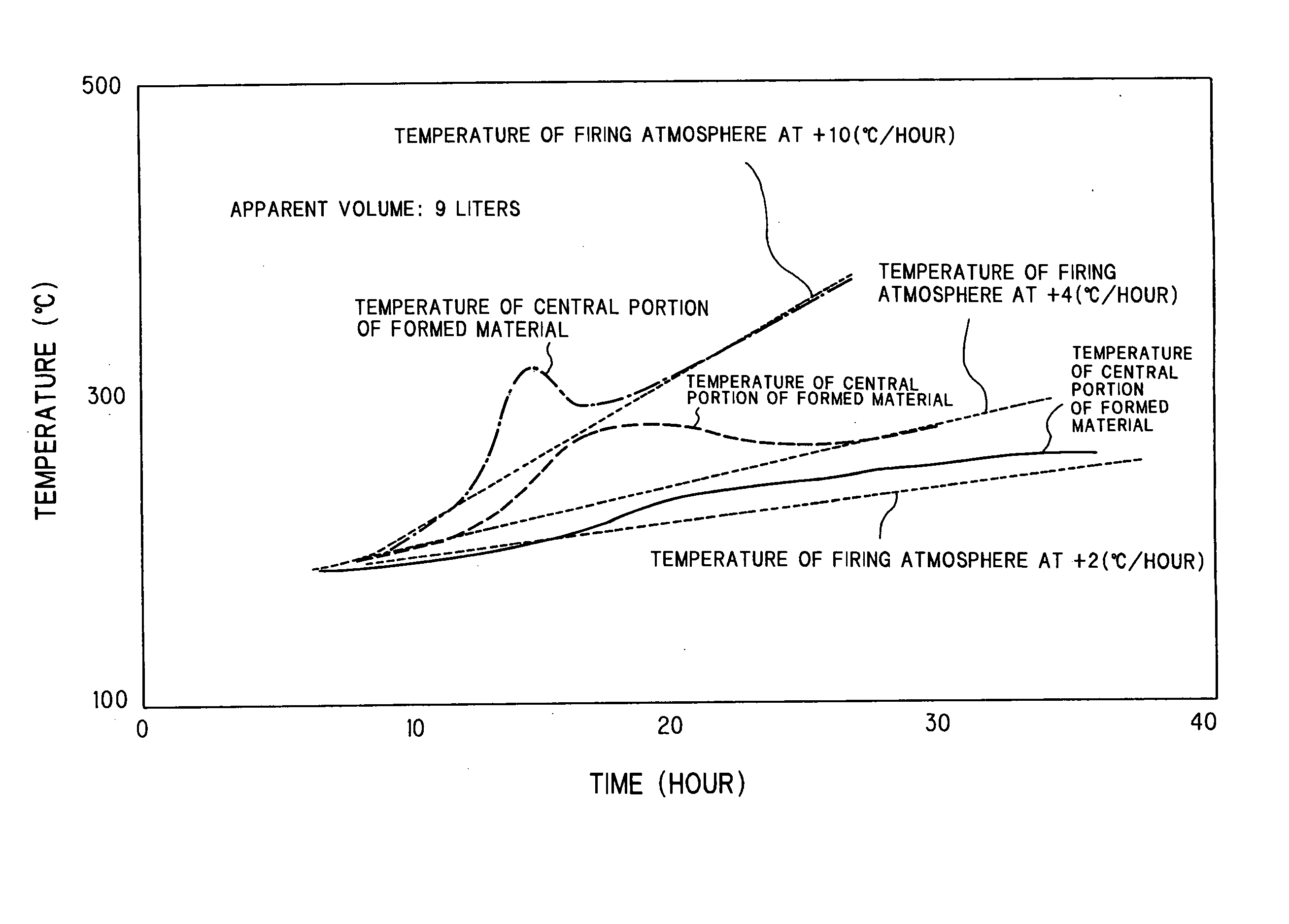Method of baking ceramic honeycomb structure
a technology of ceramic honeycomb and honeycomb, which is applied in the direction of silencing apparatus, machines/engines, domestic applications, etc., can solve the problems of large temperature difference, thermal stress inside the formed material, and defects such as cracks, and achieve the effect of strikingly shortening the conventional firing time and preventing firing defects
- Summary
- Abstract
- Description
- Claims
- Application Information
AI Technical Summary
Benefits of technology
Problems solved by technology
Method used
Image
Examples
examples
[0058] The present invention is described more specifically below by way of Examples. However, the present invention is in no way restricted by these Examples. Incidentally, in the following Examples and Comparative Examples, there was used, as the average particle diameter of the used raw material for aggregate particles, a 50% particle diameter obtained by a measurement using a particle size distribution tester of X-ray transmission type (for example, Sedigraph 5000-02 produced by Shimadzu Corporation) which conducts detection by the X-ray transmission method based on the Stokes' liquid phase sedimentation method.
[Production of Formed Honeycomb Materials]
(Formed Material A)
[0059] As a raw material for aggregate particles, there was prepared a raw material to become cordierite, by mixing 40% by mass of talc (average particle diameter: 10 μm), 35% by mass of kaolin (average particle diameter: 10 μm), 10% by mass of alumina (average particle diameter: 6 μm), 10% by mass of alumin...
examples 1-1 to 1-4
and Comparative Examples 1-1 to 1-14
[0068] The formed honeycomb materials (formed materials A to C) were fired each under the conditions shown in Table 1 to investigate the influence of the temperature elevation rate of firing atmosphere in the temperature range (180 to 300° C.) of binder burning, on the defects of firing such as crack and the like and the time of firing. Incidentally, the firing was conducted using a batch type oven.
[0069] In Table 1, the temperature elevation rate of firing atmosphere in the temperature range of binder burning was expressed as “180 to 300° C. temperature elevation rate”; the maximum temperature difference in the temperature range of binder burning, of the temperature of central portion of formed material from the temperature of firing atmosphere was expressed as “180 to 300° C. maximum temperature difference”; the temperature elevation rate of firing atmosphere in the temperature range of talc dehydration was expressed as “800 to 1,000 temperatur...
examples 2-1 to 2-9
and Comparative Examples 2-1 to 2-6
[0078] The formed honeycomb materials (formed materials A to C) were fired each under the conditions shown in Table 2 to investigate the influence of the temperature elevation rate of firing atmosphere in the temperature range (800 to 1,000° C.) of talc dehydration, on the defects of firing such as crack and the like and the time of firing. Incidentally, the firing was conducted using a batch type oven.
[0079] In Table 2, the temperature elevation rate of firing atmosphere in the temperature range of binder burning was expressed as “180 to 300° C. temperature elevation rate”; the maximum temperature difference in the temperature range of binder burning, of the temperature of central portion of formed material from the temperature of firing atmosphere was expressed as “180 to 300° C. maximum temperature difference”; the temperature elevation rate of firing atmosphere in the temperature range of talc dehydration was expressed as “800 to 1,000° C. tem...
PUM
| Property | Measurement | Unit |
|---|---|---|
| Temperature | aaaaa | aaaaa |
| Temperature | aaaaa | aaaaa |
| Temperature | aaaaa | aaaaa |
Abstract
Description
Claims
Application Information
 Login to View More
Login to View More - R&D
- Intellectual Property
- Life Sciences
- Materials
- Tech Scout
- Unparalleled Data Quality
- Higher Quality Content
- 60% Fewer Hallucinations
Browse by: Latest US Patents, China's latest patents, Technical Efficacy Thesaurus, Application Domain, Technology Topic, Popular Technical Reports.
© 2025 PatSnap. All rights reserved.Legal|Privacy policy|Modern Slavery Act Transparency Statement|Sitemap|About US| Contact US: help@patsnap.com



